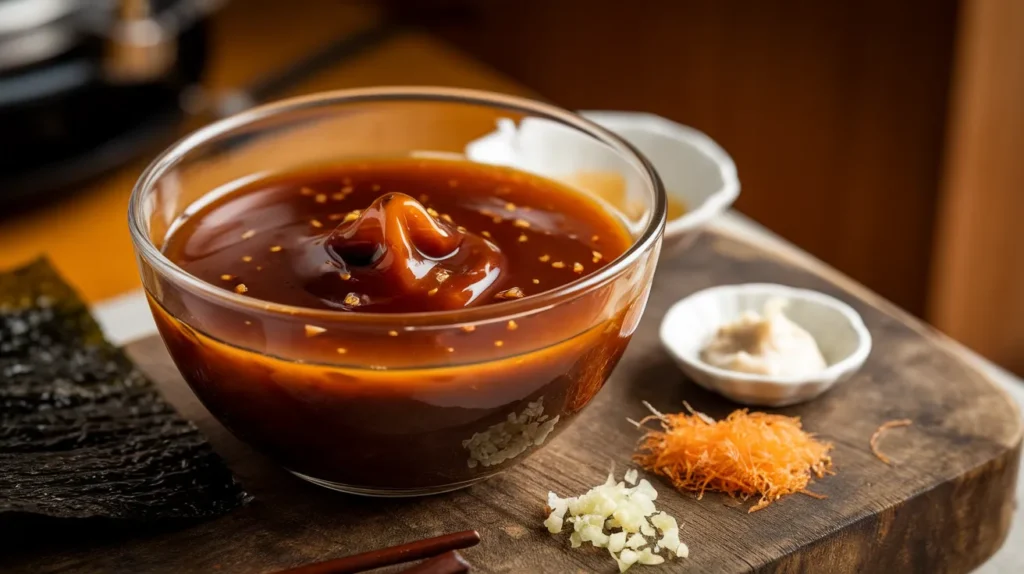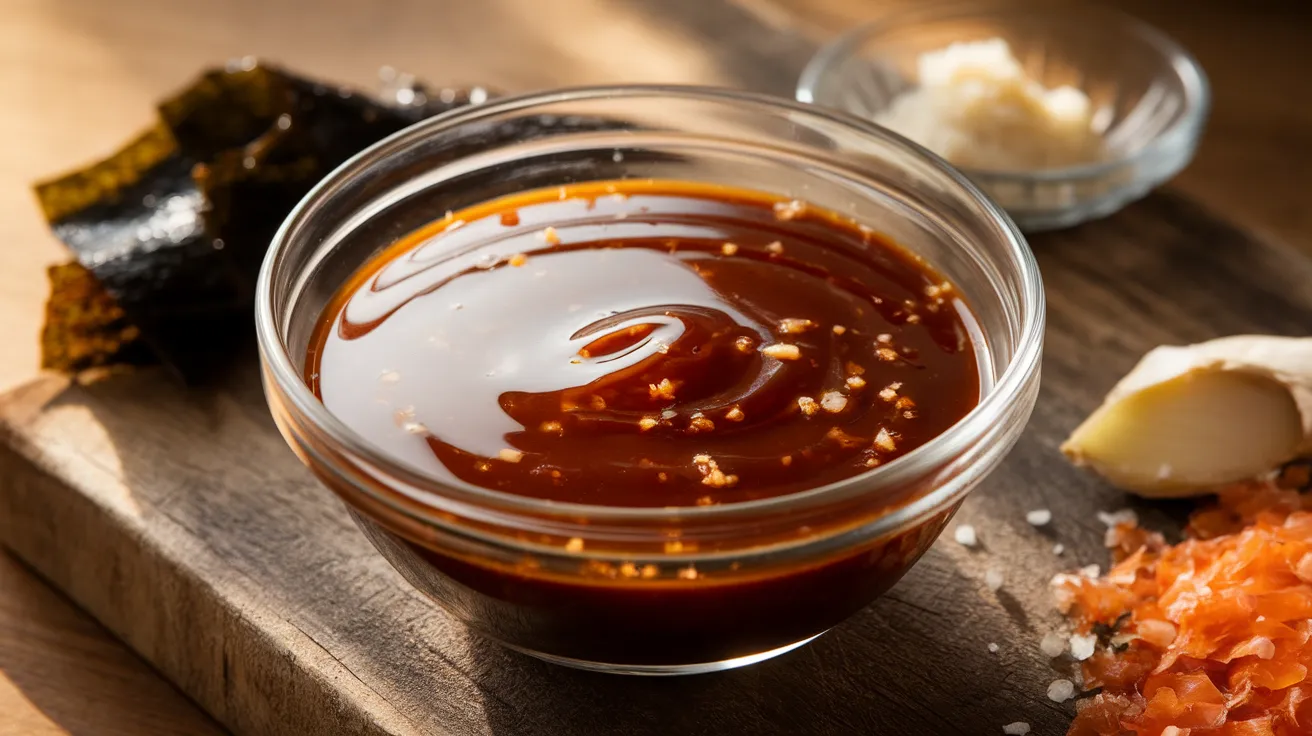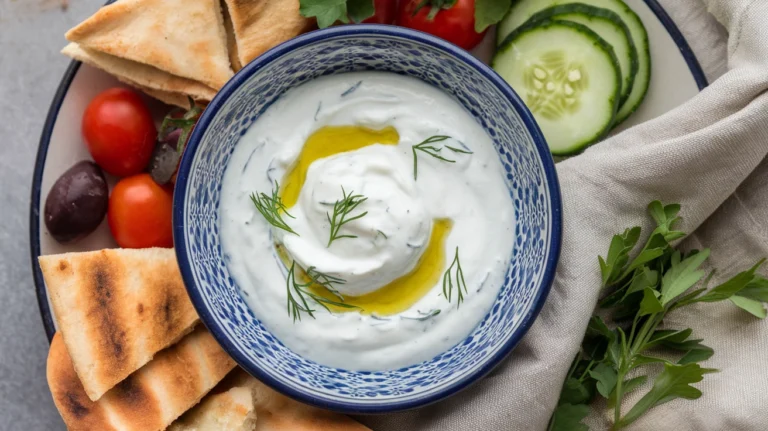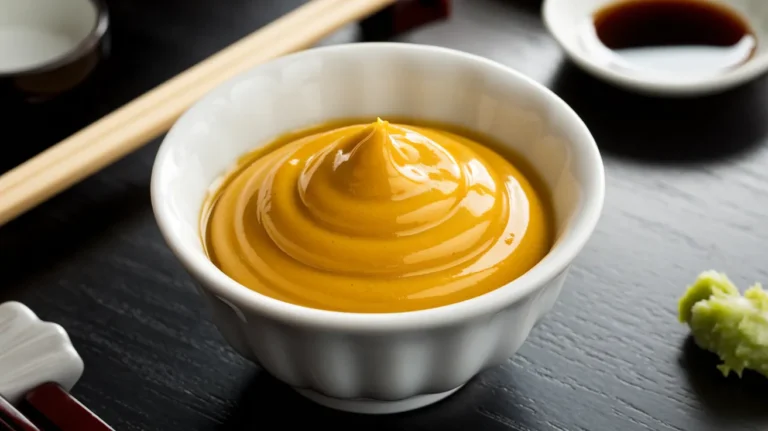Ramen tare is the concentrated flavor base that transforms simple broth into restaurant-quality ramen. This essential sauce blend creates the soul of authentic Japanese ramen, delivering umami depth that makes every bowl irresistible. Our foolproof ramen tare recipe ensures perfect seasoning balance for four generous servings.
SERVES: 4 | PREP: 15 MIN | COOK: 25 MIN | TOTAL: 40 MIN
Ingredients
Base Aromatics
- 4 cloves garlic, minced
- 1 piece fresh ginger (2 inches), grated
- 3 green onions, chopped fine
- 2 tablespoons sesame oil
Sauce Components
- 6 tablespoons soy sauce (preferably Japanese)
- 3 tablespoons miso paste (red or white)
- 2 tablespoons sake or dry white wine
- 1 tablespoon rice vinegar
- 1 teaspoon sugar
Umami Boosters
- 2 tablespoons bonito flakes (katsuobushi)
- 1 piece kombu seaweed (4 inches)
- 1 tablespoon oyster sauce
- 1 teaspoon fish sauce
Step-by-Step Instructions
Phase 1: Aromatic Foundation (5 minutes)
Step 1: Heat sesame oil in a medium saucepan over medium-low heat. The oil should shimmer but not smoke – this gentle temperature prevents burning the delicate aromatics.
Step 2: Add minced garlic and grated ginger to the warm oil. Stir constantly for 60-90 seconds until fragrant but not browned. Tip: If garlic starts browning, immediately lower heat.
Step 3: Add chopped green onions and cook for another 30 seconds. The onions should soften slightly while maintaining their bright color.
Phase 2: Sauce Building (8 minutes)
Step 4: Pour in sake or wine, stirring to deglaze any bits stuck to the pan. Let alcohol cook off for 30 seconds – you’ll smell the harsh alcohol scent disappear.
Step 5: Add soy sauce gradually while stirring. This prevents the sauce from spattering and ensures even mixing with the aromatics.
Step 6: Whisk in miso paste until completely smooth. Important: Break up any lumps against the pan sides using your whisk to prevent grainy texture.
Step 7: Stir in rice vinegar, sugar, oyster sauce, and fish sauce. Mix thoroughly until sugar dissolves completely, about 1 minute.
Phase 3: Umami Development (12 minutes)
Step 8: Add kombu seaweed piece to the mixture. Reduce heat to low and simmer gently for 5 minutes. The kombu will darken and release oceanic flavors.
Step 9: Remove kombu using tongs and discard. Why this matters: Extended cooking makes kombu bitter and slimy.
Step 10: Sprinkle bonito flakes over the surface. Let them steep for 3 minutes without stirring – this extracts maximum smoky fish essence.
Step 11: Strain the mixture through fine-mesh strainer, pressing bonito flakes gently to extract liquid. Reserve the strained tare sauce.
Step 12: Taste and adjust seasoning. Add pinches of sugar for sweetness or drops of soy sauce for saltiness. Perfect balance: You should taste salty, sweet, and umami equally.
Chef’s Notes
Miso Selection: Red miso creates robust, earthy ramen tare with deeper color, while white miso produces lighter, sweeter results. Experiment with both for different ramen styles.
Storage Secret: Fresh ramen tare keeps refrigerated for two weeks in airtight containers. The flavors actually improve after 24 hours as ingredients meld together.
Consistency Tip: Your finished tare should coat the back of a spoon lightly. If too thick, thin with small amounts of warm water or sake.
Quality Matters: Japanese soy sauce and authentic miso paste make significant flavor differences. Invest in quality ingredients for restaurant-level ramen tare results.
Nutrition Information (Per Serving)
- Calories: 85
- Protein: 4g
- Carbohydrates: 8g
- Fat: 4g
- Sodium: 1,240mg
- Fiber: 1g
Creative Variations
Spicy Ramen Tare: Add 1-2 tablespoons gochujang or sriracha during sauce building phase. This creates Korean-inspired heat that pairs beautifully with rich broths.
Vegetarian Tare: Replace bonito flakes with dried shiitake mushrooms and substitute soy sauce for fish sauce. Steep mushrooms for 5 minutes, then strain for pure umami depth.
Garlic Lover’s Tare: Double the garlic and add 1 tablespoon black garlic paste for sweet, molasses-like complexity that complements traditional flavors perfectly.
Citrus Bright Tare: Incorporate 1 tablespoon fresh yuzu juice or lemon zest during final seasoning. This variation brightens heavy tonkotsu broths beautifully, similar to how gyoza sauce adds brightness to dumplings.
Storage & Reheating
Refrigeration: Store ramen tare in glass jars or plastic containers for up to 14 days. Label with preparation date for food safety tracking.
Freezing: Portion tare into ice cube trays for individual servings. Frozen cubes last three months and thaw quickly in hot broth.
Reheating: Warm gently in small saucepan over low heat, stirring frequently. Never microwave – this breaks the emulsion and creates uneven heating.
Serving Temperature: Use tare at room temperature or slightly warm. Cold tare doesn’t distribute evenly through hot broth and affects overall ramen temperature.

Troubleshooting Guide
Problem: Tare tastes too salty Solution: Balance with 1/2 teaspoon sugar and 1 tablespoon sake. The sweetness counters saltiness while alcohol adds complexity.
Problem: Sauce separates or looks grainy Solution: Whisk vigorously while reheating gently. Emulsification breaks from high heat or inadequate mixing during preparation.
Problem: Lacks depth and tastes flat Solution: Add 1 teaspoon fish sauce and pinch of sugar. These ingredients boost umami and roundness without overwhelming other flavors.
Problem: Too thick for easy mixing Solution: Thin with warm sake or mirin, adding 1 teaspoon at a time. Maintain flavor concentration while improving consistency.
Problem: Bitter aftertaste developing Solution: This indicates overcooked aromatics or extended kombu steeping. Start fresh batch and monitor temperatures carefully throughout cooking process.
Equipment Essentials
- Medium saucepan (2-3 quart capacity)
- Fine-mesh strainer for clarity
- Whisk for smooth mixing
- Measuring spoons for precision
- Glass storage jars with tight lids
- Grater for fresh ginger
- Sharp knife for aromatics
Shopping List
Asian Market Section
- Kombu seaweed
- Bonito flakes (katsuobushi)
- Japanese soy sauce
- Miso paste
- Sake
Produce Department
- Fresh ginger root
- Garlic bulbs
- Green onions
Condiment Aisle
- Sesame oil
- Rice vinegar
- Oyster sauce
- Fish sauce
Success Secrets
1. Always taste your base ingredients before cooking. Different miso brands vary significantly in saltiness and intensity, affecting final ramen tare balance.
2. Control your heat religiously. High temperatures destroy delicate aromatics and create bitter notes that overpower the balanced flavor profile you’re building.
3. Strain thoroughly for restaurant-quality clarity. Professional ramen shops prize clean, smooth tare that doesn’t cloud the beautiful broth presentation.
4. Make double batches efficiently. Ramen tare improves with age and freezes beautifully, making meal prep simple for future ramen cravings.
5. Experiment with ratios gradually. Start with this base recipe, then adjust individual components by small amounts until you discover your perfect personal ramen tare blend. Just like perfecting tempura dipping sauce, small adjustments create big flavor improvements.




